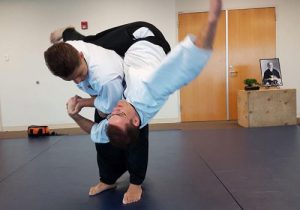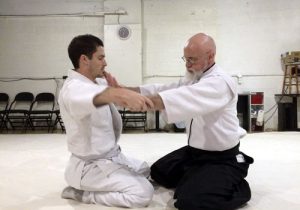
One of the most elusive and difficult concepts for westerners to understand is the Japanese concept of ‘ki’ (気). For Aikido practitioners, ki is usually translated as ‘energy.’ In it’s simplest form, it’s the kinetic energy that an Aikidoist takes from an attacker and redirects to perform a throw or take the aggressor to the ground. After all, ki is literally central to Aikido as the central character of the name of the art (合気道).
This is not to minimize the difficulty of learning to use this form of ki in Aikido. It takes the average practitioner years of training to even begin to feel ki as energy. Most people spend the first 4-5 years just learning to perform Aikido techniques with enough proficiency to be able start sensing the movement of energy between nage (the person performing the technique) and uke (the person receiving it). Only then can you start to comprehend and take the first steps on the next phase of the journey that is Aikido.
However, the concept of ki is much more vast than kinetic energy alone. Ki has many meanings in the Japanese language. It can be translated as spirit, heart, mind, will, intention, feelings, mood, air, flavor, and even humor. In short, ki is life or liveliness. The Chinese equivalent is ‘qi’ or ‘chi’, which is usually translated as the vital force forming part of any living thing (sound familiar Star Wars fans?). When used in conjunction with other Japanese verbs, ki can be used as an expression of the life within you. For example, both 気分が悪い (“I’m not feeling well”) and 病気です (“I’m sick”), both contain the character for ki and are expressions of the fact that your life energy isn’t doing very well, or you are experiencing negative ki. On the other hand, 気に入る- (“to like something”), is an expression of positive ki or positive feelings toward something.

So how does this relate to life’s challenges? It all comes down to the ability to harness ki for your benefit and the benefit of those around you. In a physical confrontation, there are basically three choices: 1) you can fight back—by opposing force with force, 2) you can submit completely, by cowering or taking a beating, or 3) you can follow the path of Aikido, which is to take the energy and redirect it in a way that results in a positive outcome for everyone involved. In other words, nobody gets hurt—everybody wins.
When faced with a challenge in your life, consider this: are you going to act? Or are you going to be acted upon? And perhaps even more importantly, how are you going to act? Will your actions hurt others? Or can you redirect the energy in a way that allows a positive outcome for everyone concerned? These principles can be applied to any hard situation: a crisis at work, trouble in a relationship, or health problems (just to name a few). Basically, it’s the principle of using the energy of life to make the situation better.
In the words of Aikido founder Morihei Ueshiba:
By virtue of the subtle working of ki, we harmonize mind and body and the relationship between the individual and the universe. When the subtle working of ki is unhealthy, the world falls into confusion and the universe into chaos. The harmonizing of a united ki-mind-body with the activity of the universe is critical for the order and peace in the world.1
Aikido training can help with life’s challenges by improving your awareness of your relationship with yourself and others (and ultimately, the universe). And consistent, serious practice will help you learn to take whatever life throws at you and still achieve a positive outcome.
If you’re interested in learning more about how Aikido can help you use the positive energy of ki to improve your life, we invite you to join us at Aikido of Salt Lake. We’re conveniently located near downtown Salt Lake City.
1. The Spirit of Aikido. Kisshomaru Ueshiba. p. 24. Kodansha International Ltd. 1984.


